Articles
- Page Path
- HOME > J Korean Acad Nurs > Volume 41(5); 2011 > Article
-
Original Article
- Maternal and Hospital Factors Impacting the Utilization of Rooming-in Care in South Korea: Secondary Analysis of National Health Data
- Yunmi Kim, Eun-Young Kim
-
Journal of Korean Academy of Nursing 2011;41(5):593-602.
DOI: https://doi.org/10.4040/jkan.2011.41.5.593
Published online: October 31, 2011
1Associate Professor, Department of Nursing, Eulji university, Seongnam, Korea.
2Associate Professor, Department of Nursing, Dong-A university, Busan, Korea.
- Address reprint requests to: Kim, Eun-Young. Department of Nursing, Dong-A University, 3 Dongdaeshin-dong, Seo-gu, Busan 602-714, Korea. Tel: +82-51-240-2785, Fax: +82-51-240-2920, eykim@dau.ac.kr
• Received: March 10, 2011 • Accepted: October 24, 2011
© 2011 Korean Society of Nursing Science
Abstract
-
Purpose
- Purpose: In this study analysis was done of utilization of rooming-in care in South Korean hospitals in order to examine the factors related to mothers and hospitals that affect rooming-in care.
-
Methods
- With the involvement of 254,414 mothers who gave birth across 953 hospitals, the analysis used the health insurance qualification data of the National Health Insurance Corporations and Health Insurance Review and Assessment Service (2006). Factors associated with rooming-in care were analyzed using a GEE logistic regression analysis to consider factors related to both mothers and hospitals.
-
Results
- Only 45.1% of the mothers used rooming-in care. The results of the regression analysis revealed that individual factors of the mothers were not associated with rooming-in care, whereas group factors of the hospitals were. Rooming-in care use was primarily related to small hospital, location of hospital, and higher nurse staffing level.
-
Conclusion
- The findings of this study indicate that the utilization of rooming-in care is not associated with factors an individual mother, but rather with the group factors of the hospitals. Thus, a policy-based approach considering both of these types of factors is required to enhance the utilization of rooming-in care.
- 1. Aiken LH, Clarke SP, Sloane DM, Sochalski J, Silber J. Hospital nurse staffing and patient mortality, nurse burnout, and job dissatisfaction. Journal of the American Medical Association. 2002;288:1987–1993. doi: 10.1001/jama.288.16.1987.ArticlePubMed
- 2. Buchan J, Bretherton T, Bearfield S, Jackson S. Stable but critical: The working conditions of Victorian public sector nurses in 2003. 2004;Retrieved September 1, 2006. from www.acirrt.com.
- 3. Bystrova K, Ivanova V, Edhborg M, Matthiesen A, Ransjo-Arvidson AB, Mukhamedrakhimov R, et al. Early contact versus separation: Effects on mother.infant interaction one year later. Birth. 2009;36:97–109. doi: 10.1111/j.1523-536X.2009.00307.x.ArticlePubMed
- 4. Crivelli-Kovach A, Chung EK. An evaluation of hospital breastfeeding policies in the Philadelphia metropolitan area 1994-2009: A comparison with the baby-friendly hospital initiative ten steps. Breastfeeding Medicine. 2011;6:77–84. doi: 10.1089/bfm.2010.0009.ArticlePubMed
- 5. Declercq E, Sakala C, Corry MP, Applebaum S, Risher P. Listening to mothers: Report of the first national U.S. survey of women's childbearing experiences. 2002;Retrieved August 5, 2010. from http://www.maternitywise.org/listenintomothers.
- 7. de Oliveira MI, Leal Mdo C. Rooming-in and cesarean section in maternity hospitals in the state of Rio de Janeiro, Brazil. Revista de Saude Publica. 1997;31:572–580.PubMed
- 7. Health Insurance Review & Assessment Service. Evaluation report about cesarean section delivery. 2010;Seoul, Author.
- 8. Katz MH. Multivariable analysis: A practical guide for clinicians. 2006;United Kingdom, Cambridge University Press.
- 9. Kim EY, Kim YM, Kim JS, Cho DS, Kim EK. Attitude and awareness of nurses about rooming-in system. Korean Journal of Women Health Nursing. 2010;16:137–146.ArticlePubMed
- 10. Kim YM, Jang HY, Jeong EJ, Kim EY, Kim JS, Kim EK. A study of the improvement of neonatal care system. 2008;Seoul, Hospital Nurses Association.
- 11. Kim YM, Park GY, Jang HR, Jeoung EJ, Kim JS, Kim EY. Comparisons of maternal perceptions between rooming-in and non rooming-in postpartum women. Journal of Korean Clinical Nursing Research. 2009;15:77–89.
- 12. Lee SC. Comparative analysis of multi-factors influencing on women's choose of rooming-in during their postpartum hospital stay. 2010;Incheon, Inha University. Unpublished master's thesis.
- 13. Levitt CA, Kaczorowski J, Hanvey L, Avard D, Chance GW. Breastfeeding policies and practices in Canadian hospitals providing maternity care. Canadian Medical Association Journal. 1996;155:181–188.PubMedPMC
- 14. Liamputtong P. Giving birth in the hospital: Childbirth experiences of Thai women in northern Thailand. Health Care for Women International. 2004;25:454–480. doi: 10.1080/07399330490267468.ArticlePubMed
- 15. Ministry for Health, Welfare and Family Affairs. Guidelines for health promotion program. 2007;Seoul, Authors.
- 16. Ministry for Health, Welfare and Family Affairs, & Korea Health Industry Development Institute. Guidelines for hospital evaluation programme. 2009;Seoul, Authors.
- 17. Medical law. Ministry of Government Legislation. 2010;Retrieved August 5, 2010. from http://www.moleg.go.kr.
- 18. Moore ER, Anderson GC. Randomized controlled trial of very early mother-infant skin-to-skin contact and breastfeeding status. Journal of Midwifery and Women's Health. 2007;52:116–125.ArticlePDF
- 19. Nelson EA, Taylor BJ, Jenik A, Vance J, Walmsley K, Pollard K, et al. International child care practices study: Infant sleeping environment. Early Human Development. 2001;62:43–55.PubMed
- 20. Park SH. Analysis of direct nursing activity and patient outcomes related to graded fee of nursing management for inpatient. Journal of Korean Academy of Nursing. 2003;33:122–129.ArticlePubMedPDF
- 21. Reeder SJ, Martin LL, Koniak-griffin D. Maternity nursing. 1997;New York, Lippincott.
- 22. Reise SP, Duan N. Multilevel modeling and its application in counseling psychology research. The Counseling Psychologist. 1999;27:528–551.ArticlePDF
- 23. Rice PL. Rooming-in and cultural practices: Choice or constraint? Journal of Reproductive and Infant Psychology. 2000;18:21–32.Article
- 24. Song JE, Lee MK, Chang SB. Differences of maternal fetal attachment between the rooming-in and non rooming-in groups of postpartum women. Journal of Korean Academy of Nursing. 2002;32:529–538.ArticlePDF
- 25. Svensson K, Matthiesen AS, Widstrom AM. Night rooming-in: Who decides? An example of staff influence on mother's attitude. Birth. 2005;32:99–109. doi: 10.1111/j.0730-7659.2005.00352.x.ArticlePubMed
- 26. Tu FF, Beaumont JL, Senapati S, Gordon TE. Route of hysterectomy influence and teaching hospital status. Obstetrics and Gynecology. 2009;114:73–78.ArticlePubMed
- 27. Ungerer RL, Miranda AT. Rooming-in history. Jornal de Pediatria. 1999;75:5–10.ArticlePubMed
- 28. Van den Heede K, Sermeus W, Diya L, Clarke SP, Lesaffre E, Vleugels A, et al. Nurse staffing and patient outcomes in Belgian acute hospitals: Cross-sectional analysis of administrative data. International Journal of Nursing Studies. 2008;46:928–939. doi: 10.1016/j.ijnurstu.2008.05.007.ArticlePubMedPMC
- 29. Wennberg JE. Practice variations and health care reform: Connecting the dots. Health Affairs. 2004;Suppl Variation. VAR140–VAR144. doi: 10.1377/hlthaff.var.140.
- 30. World Health Organization. Evidence for the 10 steps to successful breastfeeding (rev.ed., WHO/CHD/98.9). 1998;Geneva, Author.
REFERENCES
Figure & Data
REFERENCES
Citations
Citations to this article as recorded by 

- Neonatal seizures and white matter injury: Role of rotavirus infection and probiotics
Jung Sook Yeom, Ji Sook Park, Young-Soo Kim, Rock Bum Kim, Dae-Sup Choi, Ju-Young Chung, Tae-Hee Han, Ji-Hyun Seo, Eun Sil Park, Jae-Young Lim, Hyang-Ok Woo, Hee-Shang Youn, Chan-Hoo Park
Brain and Development.2019; 41(1): 19. CrossRef
Maternal and Hospital Factors Impacting the Utilization of Rooming-in Care in South Korea: Secondary Analysis of National Health Data
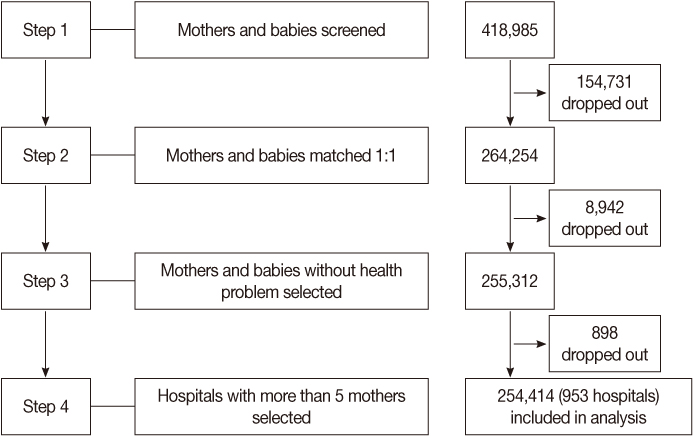
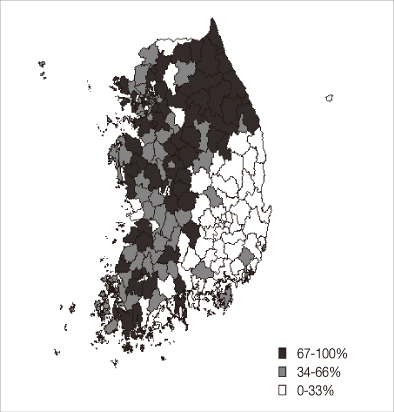
Figure 1
Participant selection process.
Figure 2
The maps of rooming-in rates.
Figure 1
Figure 2
Maternal and Hospital Factors Impacting the Utilization of Rooming-in Care in South Korea: Secondary Analysis of National Health Data
Characteristics of Hospitals
General Characteristics of Mothers (N=254,414)
Utilization of Rooming-in Care by General Characteristic of Mothers and Hospitals
*Including Busan, Daegu, and Ulsan.
GEE Logistic Regression on Use of Rooming-in Care
*Including Busan, Daegu, and Ulsan; GEE=Generalized estimation equation.
Table 1
Characteristics of Hospitals
Table 2
General Characteristics of Mothers (N=254,414)
Table 3
Utilization of Rooming-in Care by General Characteristic of Mothers and Hospitals
*Including Busan, Daegu, and Ulsan.
Table 4
GEE Logistic Regression on Use of Rooming-in Care
*Including Busan, Daegu, and Ulsan; GEE=Generalized estimation equation.
 KSNS
KSNS
 E-SUBMISSION
E-SUBMISSION


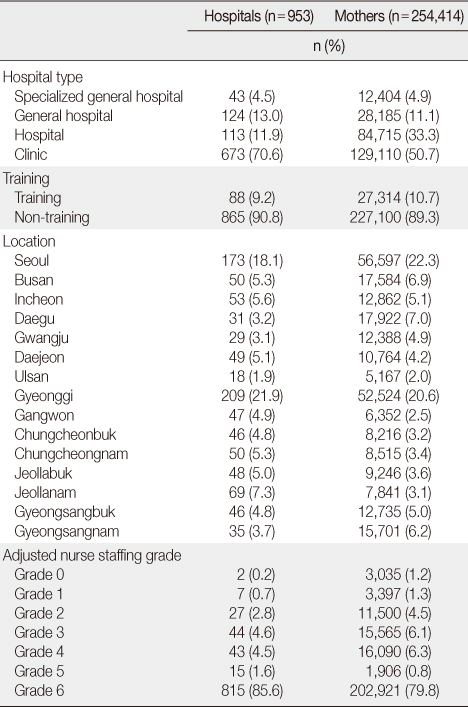
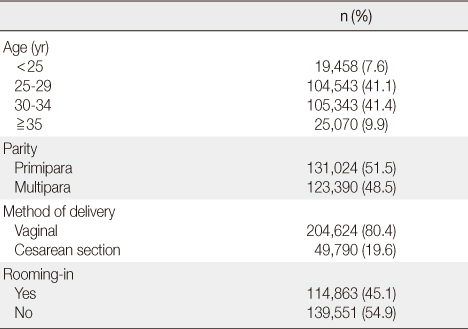
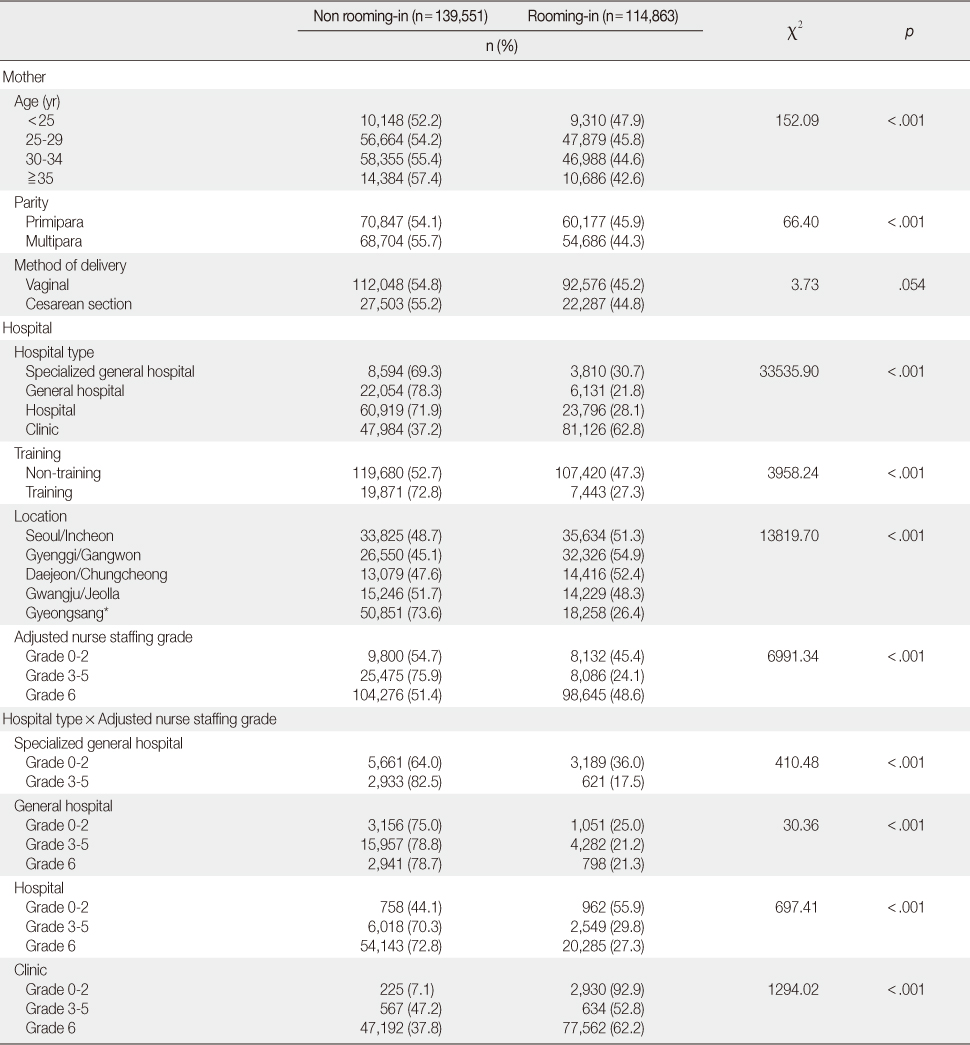
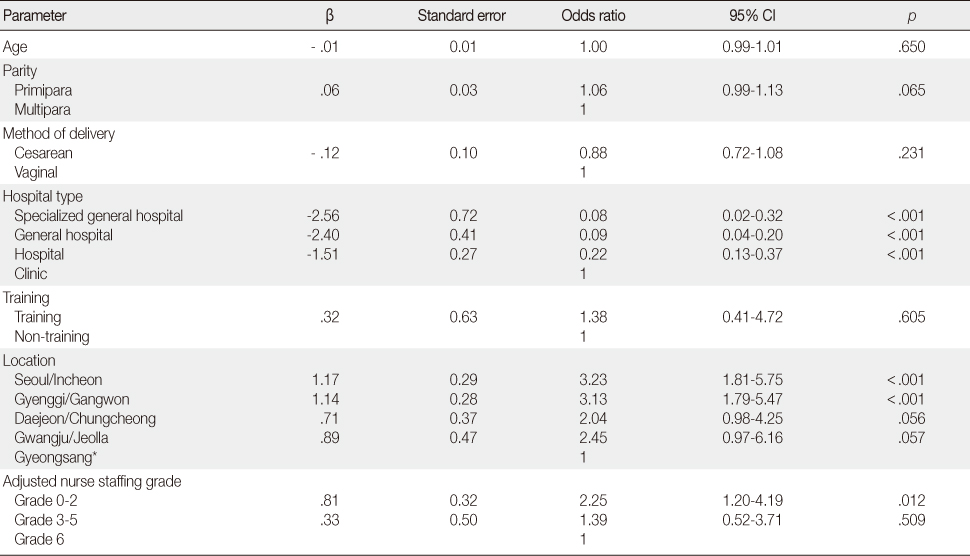
 Cite
Cite

